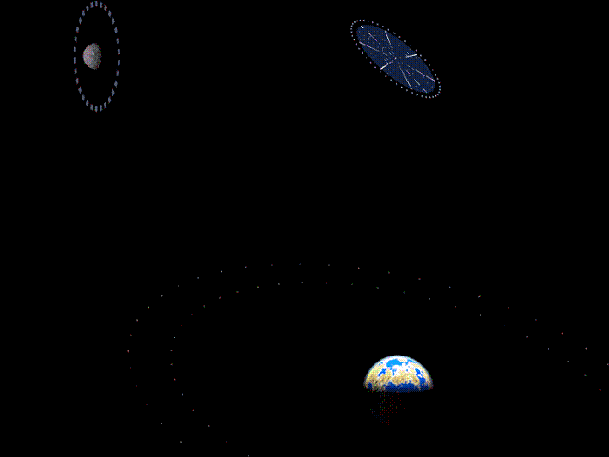BY LETTER
Sunshaper
Technology > Application > Envirotech
Technology > Application > Infrastructure
Technology > Application > Megascale Engineering
Technology > Application > Infrastructure
Technology > Application > Megascale Engineering
Sunshields, Solar mirrors and Solettas for planetary environment regulation | |
 Image from Steve Bowers | |
| This Soletta-type sunshaper includes several rings of mirrors to collect extra sunlight and focus it onto the target world | |
Originally proposed during the early Solsys Era as a means of combating global warming, the Sunshaper didn't come into its own until the Early Federation Age.
Sunshapers come in a wide array of designs and capabilities. The most basic sunshaper is simply a screen, large enough to eclipse the local star, that is placed in a planet's L1 position. This allows the insolation of the planet to be controlled very exactly, to the level of selectively illuminating or shading alternating hectares, and by itself can be used to crudely effect weather patterns.
A second, third, or fourth sunshaper, in the form of a selective mirror, can be placed at each of the Lagrange positions 4, 5 and 2. When a sunshaper is placed in one of a planet's Trojans, insolation can be increased over almost another quarter of the surface per sunshaper. Adding a mirror to the L2 point, in conjunction with one in either of the Trojans, permits a world to be illuminated over nearly the entire surface at any time. Combining shades and mirrors can allow any planet to be given insolation suitable to maintain any type of climate over any part of itself; from freezing arctic conditions at the equator to tropical climes at or near the poles. Sunshapers can also be used to modify nearly any world to have a perceived "day" and "night" cycle of any length desired by the engineers, as well as to "mold" the seasons in cases where year-lengths are significantly different from a clade's normal preference. With just four sunshapers to alter stellar transmission and reflection, it is possible to create any diurnal or seasonal variation desired, without regard to a planet's orbit or rotation.
On tidally-locked worlds, it is common to employ a Sunshaper at the L1 point to shade the planet, then to use additional sunshapers, both in the Trojans and in orbit, to provide a diurnal cycle of any desired period, complete with simulated sunrises and sunsets.
Sunshapers, by themselves, are not nearly the equal of purpose-built weather machines at controlling environmental conditions, but do not require an existing atmosphere to function. The technology is also unaffected by the frequently caustic atmospheres of Cytherean planets early in the terraforming process and is a popular choice for the regulation of weather conditions until such time as a more elaborate angelnet, including dedicated weather machines, can be installed. Even after angelnet installation, sunshapers remain useful for their ability to regulate day and season length and intensity, and to handle some of the "heavy lifting" in managing tradewinds. This allows for more efficient climate control, in terms of the equipment needed, than relying upon either weather machines alone, or weather machines paired with utility fog.
On worlds with days that are already of a suitable length, but which involve stars that have a color that is noticeably different from what is desired, sunshapers can be used to alter the color of the light to center around the frequency preferred by the target population. Initially, this was 560nm, commonly labeled as yellow light, that early (near)baseline humans, and other unaltered Terragen life, found most pleasing. In the modern era, sunshapers are as likely to be used to alter the apparent light color and intensity of the local star to simulate the appearance of anything from red-dwarfs to blue giants. However, "yellow" light is still quite popular, especially among adherents of the Bluesky movement, and other reconstructionist groups.
Because of their ability to control day and season length to such a fine degree, sunshapers are often preferred even on planets that retain worldhouses, domes, and other highly divisible environments. While habitat windows and U-fog are capable of filtering and reconstructing what light reaches them to present the inhabitant with a similar experience, they are less able to redirect the unwanted light to other uses outside of recharging their own batteries.
 Image from Steve Bowers | |
| The sunshield that protects Venus from the direct rays of Sol can be made as opaque or transparent as necessary to emulate an Earth-like day-night cycle. | |
Sunshaper technology is also applicable to Dyson Swarm mirrors. Dyson Swarm structures, which exist primarily for this role, are also called "Sunshapers" while Dyson Swarm components which primarily serve in a different role, such as habitation, but which have an attached "Sunshaper Array", are not. These Dyson Swarm Sunshapers are capable of servicing a very large number of locations, often all the habitats of even highly populated solar systems, and allow even locations very distant from the local star to enjoy insolation on par with habitable zone worlds.
Some sunshaper designs incorporate elements similar to those found in sunlines, if the output of a star is insufficient by itself to provide a desired level of illumination to a target planet. However, experts do not all agree that these devices are in fact sunshapers, rather than variations of the sunline. The most commonly agreed upon distinction is whether or not a particular sunshaper utilizes only passive methods (mirrors, optical filters, photovoltaics, frequency shifting technologies such as fluorescent materials and second harmonic generators, and of course sunshades) in its operations, or if some amount of active mass harvesting (ice mining, starlifting, etc.) to feed higher energy lighting systems is included.
While Sunshapers represent an "old" technology, it is one which has been evolving for over ten-thousand years, with many improvements which would make modern sunshapers almost unrecognizable to the first to use or install them. Their use opened a large number of worlds which had less than optimal year length or light qualities, but were otherwise very desirable, to settlement by nearbaselines long before other techniques were available to either alter the experience for the sophont, or casually alter the sophont for the experience. Today, Sunshapers are just one more, largely invisible, component in the terraforming toolkit, and are used to tailor a wide variety of worlds and habitats to an equally wide audience.
 Image from Anders Sandberg | |
| Kirch is one of numerous worlds which rely on reflected, indirect sunlight. The solar shade (not shown) is located at the L1 point, and an adjustable orbital mirror to provide illumination as required. | |
Related Articles
Appears in Topics
Development Notes
Text by Sean R
Initially published on 18 September 2019.
Initially published on 18 September 2019.






